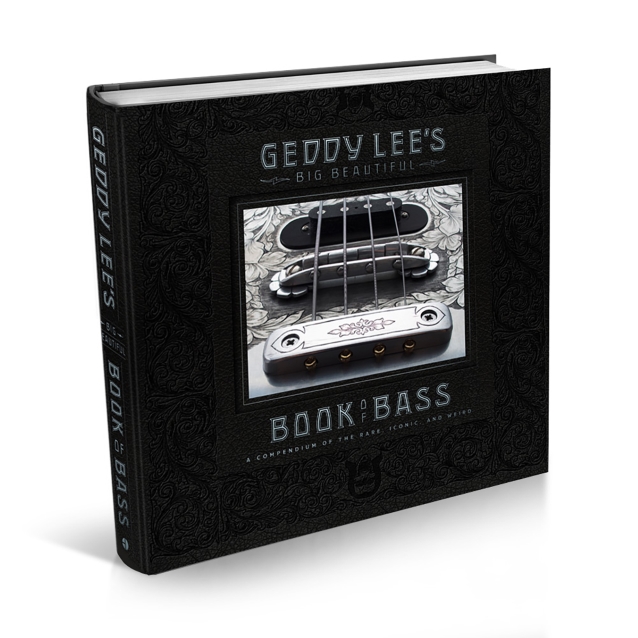Set for publication on Tuesday (December 18) is “Geddy Lee’s Big Beautiful Book Of Bass”. The standard edition of the 408-page hardcover tome sells for $75 and showcases the bulk of Geddy‘s personal collection of bass guitars. According to the press release: “Geddy‘s love of the bass has been nurtured over a lifetime spent in the limelight as one of the world’s premier rock bassists. For the past seven years, he’s dedicated himself to studying the history of the instrument that’s been so essential to his career, collecting hundreds of basses from around the globe, 250 of which are presented here in breathtaking detail with specially commissioned photography by Richard Sibbald.”
Among the instruments showcased in the book are by Fender, Gibson/Epiphone, Rickenbacker, Hofner, Ampeg — and lesser-known but influential global luthiers such as Antonio Wandr Pioli, Dan Armstrong and Tony Zemaitis.
Interspersed in the book are interviews by such high-profile players and technicians as John Paul Jones, Adam Clayton, Robert Trujillo, Jeff Tweedy, Bill Wyman, Les Claypool, along with Pete Townshend‘s legendary guitar tech, Alan Rogan.
In a new interview with Rolling Stone, the RUSH bassist shed light on the involvement of LED ZEPPELIN‘s John Paul Jones in the new book, explaining: “First of all, he’s an incredibly lovely guy. If you ever have the opportunity to sit down with one of your heroes, it’s never an easy situation — it’s always a bit nerve-racking, and you never know what to expect. John, for example, was perfect for me because a) he was such an influential player in my life; b) he plays what I consider the greatest period of Fender Jazz Bass, a ’62, on all those early ZEP albums; and c) he’s a lovely guy. He’s the perfect combination of someone to interview.”
He went on to say that from the onset, Jones was all in with the project and understood its importance. “He took my request very seriously,” Geddy said. “I sent him a letter saying, ‘Here’s what I’m doing. I would love to sit down with you for an hour and talk about your first or favorite instrument.’ He showed up at my place in the U.K., paid for his own taxi, brought two basses with him, came over for the afternoon. He originally used this bass that he no longer owned. He actually tracked one down and purchased it so he could show me what his original bass was like. That shows the level of seriousness of the person. We just had a great talk. What I really wanted to get out of people like him and Bill Wyman were their memories and motivation — what was it like in the early ’60s to go shopping for a bass? We’re talking about basses that are 50, 60 years old now, but there are a few guys around still who knew what was available to a young player in London in the late ’50s, early ’60s. What kind of basses did you dream of owning? How were these basses that are in the book acquired, and could you afford to acquire them? All these bassists began their lives on cheaper instruments, and they made do with what they could get and aspired to these better ones. It was really fascinating.”
Lee talked about his original bass influences, citing some of the greatest players in the rock world. “In the beginnings of my formative years, I would say Jack Casady, Jack Bruce, John Entwistle, John Paul Jones, Chris Squire — these guys had the most impact on me, and in particular Chris Squire,” he said. “Because although all these guys, with maybe the exception of John Paul Jones, had a bit of twang in their sound, probably Entwistle and Squire are the ones who are most closely aligned — if you listen to ‘My Generation’, there’s a hell of a lot of twang on that bass. I think Chris Squire sort of took that idea to the next level. He played with a pick, and I never realized that until I saw him live. When I was listening to those records, I was amazed at the amount of twang and thwack. And I thought, ‘Man, how does he get that out of his fingers?’ Of course, when I saw him live, I went, ‘Ahh, pick!’ I’d been trying to do it with my fingers and thwack the shit out of my bass to get that sound. But the pick definitely helps that sound, and a lot of guys use a pick for that reason. But I developed a way of replicating (it) or at least trying to.”
It’s impossible to separate Lee‘s early days with RUSH from images of him with his Rickenbacker 4001 bass — the same instrument used by two of his biggest influences — Paul McCartney and YES co-founder Chris Squire. “We’re so accustomed to them now, but when you think back to that moment — I do remember seeing Paul McCartney on television and going, ‘What is that?'” Geddy said. “That was my first experience with the cresting wave of the Rickenbacker bass.”
Lee spoke about how a high school buddy turned him on to YES. “I can still recall one of the days that we ‘opted out’ of school and we’re sitting cross-legged on the floor of Oscar‘s room as he introduced me to an album called, ‘Time And A Word’ by a band called YES that I’d never heard of,” he said. “For years, people ask me why I played a Rickenbacker bass and all I have to do is point to that album, and Chris Squire‘s incredible original playing to provide the answer.”

Fonte: Blabbermouth.net











